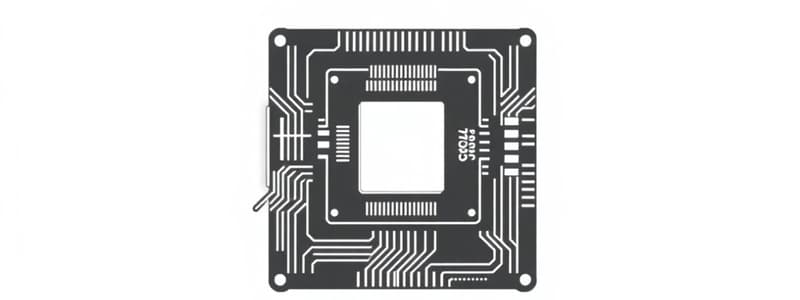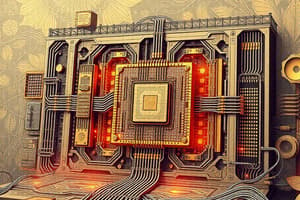Podcast
Questions and Answers
Which component of the CPU is responsible for performing arithmetic and logical operations?
Which component of the CPU is responsible for performing arithmetic and logical operations?
- Control Unit
- Arithmetic Logic Unit (ALU) (correct)
- Program Counter
- Clock Generator
Main memory (RAM) only stores program instructions.
Main memory (RAM) only stores program instructions.
False (B)
What is the function of the program counter in a CPU?
What is the function of the program counter in a CPU?
stores the memory address of the next instruction
The process of fetching an instruction from memory, decoding it, and executing it is known as the ________ cycle.
The process of fetching an instruction from memory, decoding it, and executing it is known as the ________ cycle.
Match the following computer components with their primary function:
Match the following computer components with their primary function:
Which unit coordinates the other components of a computer and is in charge of running a program?
Which unit coordinates the other components of a computer and is in charge of running a program?
The term 'random' in Random Access Memory (RAM) means that memory cells are accessed in a non-sequential manner.
The term 'random' in Random Access Memory (RAM) means that memory cells are accessed in a non-sequential manner.
What is the role of the Clock Generator in a CPU?
What is the role of the Clock Generator in a CPU?
Which of the following is NOT a component of a Boolean expression?
Which of the following is NOT a component of a Boolean expression?
What is the primary focus of high-level programming languages?
What is the primary focus of high-level programming languages?
In Python, assignment instructions directly modify the existing data object in memory.
In Python, assignment instructions directly modify the existing data object in memory.
Assembly languages use mnemonics, which are short names for machine language instructions.
Assembly languages use mnemonics, which are short names for machine language instructions.
What is the primary purpose of control flow statements in imperative programming?
What is the primary purpose of control flow statements in imperative programming?
A conditional expression consists of a boolean expression, a yes-expression, and a ______.
A conditional expression consists of a boolean expression, a yes-expression, and a ______.
What are the two essential properties of an expression in programming?
What are the two essential properties of an expression in programming?
A program written in a high-level language can be used on computers with differing hardware due to its reduced dependency on the concrete ________
A program written in a high-level language can be used on computers with differing hardware due to its reduced dependency on the concrete ________
Match the following programming paradigms with their descriptions:
Match the following programming paradigms with their descriptions:
Which of the following is an example of a function call in Python?
Which of the following is an example of a function call in Python?
Match the following expression types with their description:
Match the following expression types with their description:
Declarative programming languages directly manipulate the program counter through explicit instructions.
Declarative programming languages directly manipulate the program counter through explicit instructions.
Which of the following is NOT a typical feature of High-Level programming languages?
Which of the following is NOT a typical feature of High-Level programming languages?
What is the role of assignment instructions in imperative programming?
What is the role of assignment instructions in imperative programming?
The order of execution always follows the next instruction sequentially.
The order of execution always follows the next instruction sequentially.
In the context of assembly language instructions, what are 'mnemonics'?
In the context of assembly language instructions, what are 'mnemonics'?
Flashcards
Main Memory (RAM)
Main Memory (RAM)
The main component that stores programs and the data they use. It's like a temporary workspace for your computer.
Memory Cells
Memory Cells
A collection of memory cells, each holding a piece of data. Each cell has a unique address for easy access.
Memory Address
Memory Address
The address of a memory cell, used to locate and access the data it stores.
Central Processing Unit (CPU)
Central Processing Unit (CPU)
Signup and view all the flashcards
Control Unit
Control Unit
Signup and view all the flashcards
Arithmetic Logical Unit (ALU)
Arithmetic Logical Unit (ALU)
Signup and view all the flashcards
Program Counter
Program Counter
Signup and view all the flashcards
Bus System
Bus System
Signup and view all the flashcards
Next Instruction
Next Instruction
Signup and view all the flashcards
Jump Instruction
Jump Instruction
Signup and view all the flashcards
Conditional Branch
Conditional Branch
Signup and view all the flashcards
Assembly Language
Assembly Language
Signup and view all the flashcards
Mnemonics
Mnemonics
Signup and view all the flashcards
High-level Language
High-level Language
Signup and view all the flashcards
Expression
Expression
Signup and view all the flashcards
Constant Expressions
Constant Expressions
Signup and view all the flashcards
Boolean Expression
Boolean Expression
Signup and view all the flashcards
Conditional Expression
Conditional Expression
Signup and view all the flashcards
Function
Function
Signup and view all the flashcards
Imperative Programming
Imperative Programming
Signup and view all the flashcards
Declarative Programming
Declarative Programming
Signup and view all the flashcards
Multi-paradigm Programming
Multi-paradigm Programming
Signup and view all the flashcards
Assignment
Assignment
Signup and view all the flashcards
Control Flow
Control Flow
Signup and view all the flashcards
Study Notes
Main Memory/RAM
- Stores programs and data for programs to operate on
- Composed of memory cells
- Each cell holds a fixed number of bits (binary data words)
- Memory cells are numbered consecutively, starting from 0
- The number assigned to a cell is its address
- This architecture was first described in 1945
Central Processing Unit (CPU)
- Controls the computer's operation and executes programs
- Consists of several parts
- Control Unit: coordinates other components, manages program execution
- Arithmetic Logical Unit (ALU): performs arithmetic and logical operations (e.g., addition, subtraction, multiplication, division, bitwise operations)
- Program Counter: stores the address of the next instruction in the program
- Clock Generator: synchronizes computer components
Input/Output (I/O)
- Consists of physical devices connecting the computer to the outside world
- Examples include keyboard, mouse, USB ports, screen, network connectors, sound cards, etc.
Bus System
- Set of electronic connections
- Transports data, addresses, and clock signals between components (CPU, main memory, I/O)
Basic Operation of a Computer
- FETCH: Control unit fetches the next instruction from main memory using the program counter's address
- DECODE: Control unit interprets the instruction, finding additional operands (if needed) from main memory
- EXECUTE: Control unit coordinates other components to perform the instruction
- REPEAT: Cycle begins again for the next instruction
Assembly Languages
- Provide a simple textual representation of machine language
- Use mnemonics (short names) for instructions (e.g., ADD, SUB, MUL, CMP)
- Provide syntax for operators, memory references, and control structures
- Example program for x86-processor shown
High-Level Languages
- Focus on the programmer, not the machine
- Aim for ease of use and readability for humans
- Use higher levels of abstraction than assembly languages
- Easier to understand and debug
- Programs are less dependent on specific hardware
Expressions
- Fundamental concept in high-level programming languages
- Consist of a type and a value
- Types define possible values and operations
- Common types include integers, fractional numbers, truth values, characters, and more complex data items
- Expressions can be evaluated to determine their values
Constant Expression
- Represents a single value directly
Arithmetic Expressions
- Involve numbers and basic arithmetic operations (e.g., addition, subtraction, multiplication, division)
Boolean Expressions
- Use comparison operators and truth values
- Types are always truth values
Conditional Expressions
- Consist of a Boolean condition and two expressions
- Used to conditionally execute one or the other part, based on the condition's result
Function Calls
- Python has built-in functions
- Functions accept arguments, perform operations, and return a result
Imperative Programming
- Programs are executed by following a sequence of instructions
- These instructions change the state of the computer
Declarative Programming
- Programs describe what to compute but not how to do it
- Focus on the input and the desired output, while the computing machine handles the process
Multi-Paradigm Programming
- Combine different programming paradigms in a single program
- Example: Python combines functional, imperative, and object paradigms
Assignments
- Instructions to store or modify data in memory
Input/Output (I/O)
- Instructions to communicate with outside world (e.g., user input, file system, network)
- Detailed operations of input/output depend on the programming language and hardware interactions
Control Flow
- Instructions to control the order in which instructions are executed
- Includes jumps for altering the instruction sequence (goto instruction). Modern languages often use alternative structured approaches (e.g., branching statements, conditional executions like if-else, loops like for-loops and while-loops)
Conditional Execution(if-else)
- Execute blocks of code conditionally based on a Boolean condition
Loops
- for-loops and while-loops for repeating a block of code
Error Handling
- Methods for dealing with errors during program execution
- Abort the program
- Use a special value (like NaN)
- Define explicit error handlers (interrupt, signal)
- Use exception handling mechanism (example
try...exceptblocks in Python)
Studying That Suits You
Use AI to generate personalized quizzes and flashcards to suit your learning preferences.




